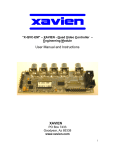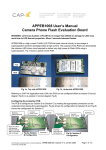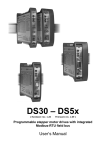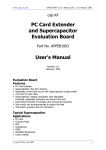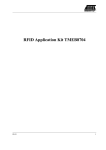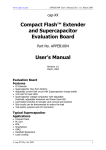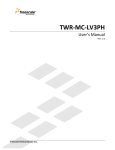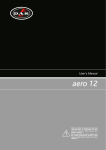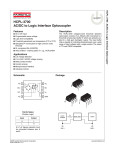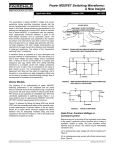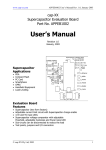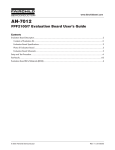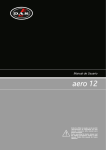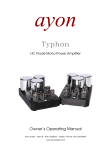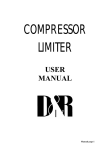Download - Cap-XX
Transcript
User’s Manual Camera Phone Flash Evaluation Board APPEB1006 All information contained herein is strictly confidential © CAP-XX Pty Limited 2005 APPEB1006 User Manual rev1.0, 31-May-2005 page 1 of 6 Camera Phone Flash Evaluation Board User’s Manual Board Features FLASH mode with adjustable voltage and current TORCH/MOVIE mode with adjustable voltage and current Vin and Vout indicating LED’s On-board or External triggering On-board or External white LED LED and inductor current measurement ability Undervoltage lockout (UVLO) Boost enable/disable during flash and torch for different power architectures Auto run for flash or torch Quick Setup The following jumpers should be in place J2, J5, J7, J8 and J10. Connect the positive terminal of a single cell Lithium Ion rechargeable battery (3.3V-4.2V) to any pin on J1 and connect the negative terminal to any pin of J3. The red LED (D1) should come on immediately and the yellow LED (D2) should increase in brightness over a few seconds whilst the supercapacitor charges up. When the TORCH push button (SW1) is pressed 100mA will flow through the white LED (D5). At 100mA the button can be held down continuously. When the FLASH push button (SW2) is pressed 1A will flow through the white LED (D5) for approximately 80ms. If the button is held down continuously the flash will retrigger approximately every 2.5s. This duty cycle is imposed due to the thermal constraints of the white LED. Circuit Description (refer to schematics at the end of this manual) Input Voltage The circuit is designed to operate from an external Li ion battery (4.2V-3.3V). Vbat is the node connected to the battery via J1. J1 is to be connected to battery positive terminal. Pins 1 and 2 of J1 are joined. J3 is to be connected to battery negative terminal. Pins 1 and 2 of J3 are joined. An undervoltage lockout (UVLO) has been included (U2B) such that when the battery voltage drops below 3.1V the main switch (MOSFET M1) opens. It will reclose with 350mV of hysteresis (3.45V). The 3V regulator remains operational during a UVLO. The main reason for the UVLO is that the boost controls Vout which is the sum of the input voltage (battery or perhaps bench top supply) plus the supercap (C1) voltage. The voltage across the supercap is not measured. Therefore, if the input voltage was say 3V and Vout was controlled to be 5.7V then the supercap would be at 2.7V which reduces its life. For maximum life the supercap should be kept below 2.3V. However, the supercapacitor voltage can be increased to 2.5V for short periods, such as while taking flash photos, without affecting life. Indicating LED’s D1 is a red LED that indicates a source voltage is present and that a UVLO has not occurred. D2 is a yellow LED and indicates that Vout is present and above approximately 5V. All information contained herein is strictly confidential © CAP-XX Pty Limited 2005 APPEB1006 User Manual rev1.0, 31-May-2005 page 2 of 6 Boost Converter J2 needs to be jumpered for normal operation. This jumper has been included so a wire loop can easily be inserted to measure the inductor current. By measuring the inductor current and monitoring the base drive voltage of Q1 the current through Q1, D3 and supercap can also be determined. J4 is not jumpered during normal operation. This jumper has been included to manually disable the boost if required. If jumpered it forces the feedback voltage at pin 6 of the boost to be 3V which is >> than the 730mV of the internal reference thereby instructing the boost to cease switching. The boost can also be disabled by pulling the gate of M3 low. This can be done automatically during a FLASH pulse by jumpering J7 or while in TORCH mode by jumpering J10. The advantage of disabling the boost during a FLASH pulse is that the maximum battery current is equal to the load (flash LED) current, however, the disadvantage is that the supercap discharge current is also equal to the load current and it will discharge at a faster rate than if the boost was enabled. The disadvantage of enabling the boost during a Flash pulse is that the maximum battery current is greater or much greater then the load current depending on the current limit set on the boost. FLASH MODE The boost generates an output voltage (Vout) that is > the battery voltage. For FLASH mode, Vout is factory set to 5.7V. This voltage can be increased by turning R17 (a 2k pot) anticlockwise. Care must be taken if this voltage is increased not to overvoltage the supercap, ie the supercap voltage will be Vout minus the voltage of the battery. For maximum supercapacitor life the voltage should be kept below 2.3V however short term overvoltages (seconds) may go up to 2.7V. TORCH MODE The continuous current required for TORCH is << FLASH current (typically 100mA Vs 1A). Therefore the voltage dropped across the LED will be less. To increase efficiency (and to reduce thermal stress on the current limiting MOSFET (M4)) Vout should also be reduced. There are two options for the TORCH Vout, if constant high output light is more important than efficiency then option a) should be chosen. a) In this option the Boost is enabled with J10 removed and J11 is jumpered. Vout can be adjusted using R12 (a 500k pot). Vout is factory set to 4.2V. This means that Vout will always be > Vin irrespective of the battery voltage. In this mode the forward voltage to drive the LED at 200mA, for example, will always be available even when the battery nears its end voltage (3.3V). b) In this option the Boost is disabled with J10 jumpered and J11 is don’t care. This means Vout will always be equal to Vin minus the drops incurred by the inductor’s (L1) DC resistance and D3. This is the most efficient mode because the current limiting MOSFET (M4) does not have to drop as many volts and the Boost is not operating. However, depending on the LED current required, there may not be enough voltage headroom in Vout when the battery nears its end voltage (3.3V). For example, if the LED current was chosen to be 200mA and the voltage across a typical LED at this current was also 3.3V then there would be no volts available across the current sense resistor (R22) and M4 and then only say 150mA would be available. Option b) is factory chosen and the TORCH current is set to 100mA. All information contained herein is strictly confidential © CAP-XX Pty Limited 2005 APPEB1006 User Manual rev1.0, 31-May-2005 page 3 of 6 The user must decide on what is the end voltage of the Li ion battery and what current gives acceptable light for the Torch. Of course the user may also decide that it is acceptable to have slightly less light output as the battery nears its end voltage (after all, most users are familiar with this behavior in an incandescent torch). Current Control The FLASH current is factory set to 1.0 Amp. It can be reduced by turning R25 (10k pot) anticlockwise. The maximum LED current rating is 2 Amps. The FLASH current needs to be adjusted prior to the TORCH current because the FLASH setting affects the TORCH setting but not vice versa. The TORCH current is factory set at 100mA. It can be reduced by turning R26 (2k pot) anticlockwise. External Flash LED An External white LED (or other load) can be connected to the board via J5. This also requires that the on-board LED (D5) be bypassed with J6. Alternatively, a second flash LED (LXCL-PWF1) can be connected in parallel to D5 across J6 (pin 2 is +ve). AutoTorch/External Torch Mode Control If J12 is jumpered, then Torch mode will be permanently on (Auto Torch). Alternatively, an external control signal connected to pin 2 of J12 will select Torch mode when Hi (3V – 5V). This logic signal drives the gates of M8, M9, and M10 and must source 0.1mA to develop 3.3V across R36. Flash PulseTimers/External Flash Pulse Control There are two on-board 555 timers. One generates the FLASH on-time and the other generates the off-time. The FLASH trigger from these timers is connected to the Current Control circuitry via J8. J8 is jumpered for normal operation. An external triggering circuit can be connected by removing the jumper from J8 and connecting the external signal to pin 1 of J8. There is a 33k pull down resistor on this pin. A logic high signal on this pin will take a FLASH. Make sure that this signal is < 100ms long and does not occur for at least another 2s otherwise the thermal limits of the white LED (D5) will be violated and it will be destroyed. Auto Flash If J13 is jumpered then the two 555 timers will be continuously triggered to generate an 80ms flash pulse every 2.5s. Further Information CAP-XX will be pleased to provide further information on the applications described here, and on the use of supercapacitors in any application. Please use the contact details on the header page, or visit the cap-XX web site. All information contained herein is strictly confidential © CAP-XX Pty Limited 2005 APPEB1006 User Manual rev1.0, 31-May-2005 page 4 of 6 Schematics C4 10u 805 Vbattery 1 J3 C5 10u 805 C6 10u 805 4 1V2 R1 82k 805 2 Vin R2 R3 33k 805 47k 805 GND M1 FDC638P SuperSOT-6 6 150 805 - 5 D1 D2 LSR976 805 LYR976 805 R4 1k 805 7 R5 1k 805 + 5 Vout Vin GND *Shdn Bypass 4 3V C12 100n 805 C11 10u 805 R18 33k 805 1V2 U4 LM4041 3 Vbat C13 10u 805 2 D4 BZX84C-4V7 SOT23 1 TS1852 R11 47k 805 U3 1 2 3 TC1185 SOT23-A 3 OUT Vout Vbat R37 U2B R8 18k 805 Vin 1 2 6 5 2 1 2 Vbat 3 1 J1 R13 1e6 805 Undervoltage Lockout Vmin = 3.1V with 350mV Hysteresis Vout 3V 1 C8 DNP 10u 805 C9 DNP 10u 805 L1 2 1 33u ELL6RH R6 3R3 805 1 2 3 4 J4 D3 U1 EM Vdrive BAS GND RE FB VCC Isense 8 7 6 5 2 3 C10 DNP 10u 805 Q1 ZXT13N50DE6 SOT23-6 R9 R047 805 R10 100k 805 Manual Boost Disable 3V R15 33k 805 R7 805 Torch Vout R30 33k 805 Offtime Trigger 3 R14 1k *Boost Disable 150k 805 C20 47n 805 C21 100n 805 APPEB1006 User Manual rev1.0, 31-May-2005 DIS TH CON RES OUT TRIG GND 1 SW2 1 J13 2 Auto Flash page 5 of 6 VCC DIS TH CON RES OUT TRIG C18 100n 805 14 13 12 11 10 9 8 R29 680k 805 3V 3 BAT754 SOT23 R33 33k 805 R34 3k3 805 R35 3V 3V C19 100n 805 Flash B3SN 1 All information contained herein is strictly confidential U5 TLC556CD SOIC R12 500k 2 T93YB R17 2k 2 T93YB LEDpulse C17 100n 805 D6 805 R16 14k3 805 3 © CAP-XX Pty Limited 2005 R32 1 FDV302P M3 SOT23 1 2 3 4 5 6 7 3V 33k M2 FDV302P SOT23 C16 10u 805 R28 220k 805 MBRA130LT3 SMA 2 Inductor Current ZXSC100 SO8 1 J2 1 2 5 6 C7 10u 805 3V 2 C1 GW101 Vin C3 10u 805 4 C2 10u 805 33k 805 Vout *Boost Disable 1 J5 2 2 + - TS1852 SO 3V Offtime Trigger R24 33k 805 J8 Pulse 1 1 R25 10k 2 T93YB 3 2 R23 220p 603 R27 FDV301N 1V2 1M5 805 M8 GND *Boost Disable 1 J12 Torch J10 2 Auto Torch M10 FDV301N R36 33k 805 All information contained herein is strictly confidential © CAP-XX Pty Limited 2005 J11 Torch Boost Disable FDV301N APPEB1006 User Manual rev1.0, 31-May-2005 Torch Voltage 1 B3SN M9 Torch Vout 2 Torch/*Flash 1 SW1 2 FDV301N 3V page 6 of 6 M4 4 ZXM64NO2X MSOP8 R22 R047 805 1 1 M7 C15 3k3 805 R26 2k 2 T93YB R31 33k FDV301N 805 External Timer J9 3 M6 150 805 4 2 R20 33k 805 R21 1 Vdd OUT FDV301N 2 U2A 1 2 3 3 M5 Vcc 8 3V J6 LED Bypass 1 C14 100n 805 1 R19 100k 805 LumiLED ? 5 6 7 8 1V2 Pulse Boost Disable LEDpulse D5 3V J7 2 LED Current







